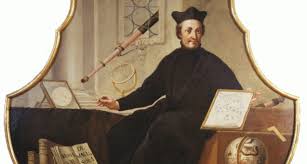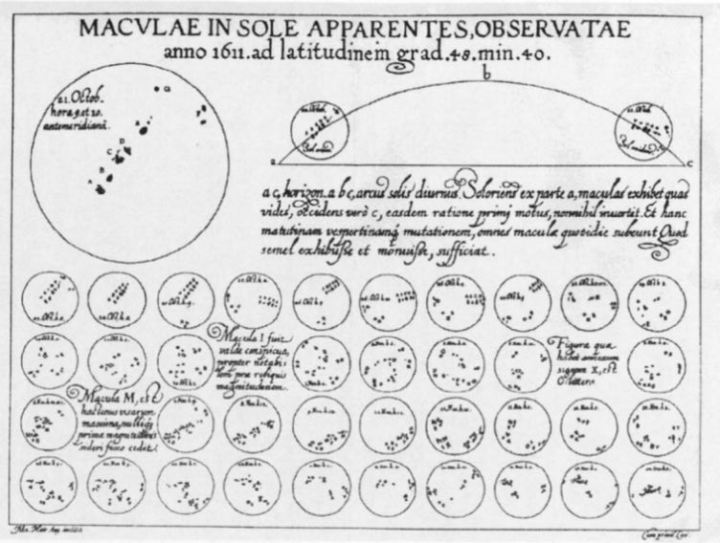
Christoph Scheiner SJ (1537-1650)
Christoph Scheiner SJ (25 July 1573 – 18 June 1650) was a Jesuit priest, physicist and astronomer. He was born in Markt Wald bei Mindelheim, belonging at that time to the House Habsburg. He entered the Jesuit Order in Landsberg am Lech on 26 October 1595. He spent the years 1598–1609 in Ingolstadt studying philosophy (metaphysics and mathematics) and theology. Already in 1603, Scheiner invented the pantograph, an instrument designed to reproduce drawings on a different scale. It consists of four hinged rods in the form of a parallelogram with hinge points varying according to the scale of reproduction. It is equipped with a fixed center and two points: a dry one that follows the outline of the original design, and the other writer who tracks the reproduction in an enlarged or reduced form. Due to this invention, he rapidly gained celebrity status.
On 18 April 1609, Scheiner received priestly ordination. In 1610, he was appointed professor of mathematics in Ingolstadt. of Ingolstadt, teaching mathematics (physics and astronomy) and Hebrew. He lectured on sun dials, practical geometry, astronomy, optics, and the telescope.
Scheiner is considered a co-discoverer of the sunspots, together with Galileo Galilei, Thomas Harriot, and Johann Fabricius. Together with his student Johann Baptist Cysat, he could observe the sunspots from the tower of the Holy Cross Church in Ingolstadt in March and October 1611, and originally described them as satellites since in the Aristotelian notion, the sun is perfect and pure. He communicated this in three letters first to the banker and scholar Mark Welser who printed them and brought them to the attention of the Accademia dei Lincei and ultimately to Galilei. Galilei had independently observed the sunspots starting in May 1611 and published his findings in 1612 through the Lincean Academy. Galileo could show that the sunspots were at or near the surface of the sun, a view that Scheiner opposed for several years but finally adopted. Scheiner and Galilei engaged in scientific discourse fiercely debating (1) the priority in the observation, (2) its application to Tycho Brahe’s modified geocentric model versus the heliocentric view and (3) the nature of the sunspots. Scheiner and Galilei remained divided and the pride of both even aggravated the tone in these discussions. It is not known what Scheiner really thought, but one fact stands clear: maybe only in obedience to his superiors in the Jesuit order or following his own conviction, he defended the Tychonic geocentric model during the remainder of his life. In the following years, Scheiner and his students made extensive observations on the sunspots that were finally published in Scheiner’s ‘Rosa Ursini sive Sol‘ in 1630. Contrary to the prevalent view at that time that the sun is solid, he expressed his revolutionary opinion – based on his observations – that the Sun might be fluid.

Composite of Scheiner’s Sunspot Observations of 1612 (taken from van Helden A.)
Christoph Scheiner also made an important contribution on the theory of vision. In 1583, the physician Felix Platter (1536-1614) was the first to suggest that the structure responsible for sensitivity to light was the optic nerve (seen today’s knowledge this is wrong) and the retina (correct). Kepler proposed that the image (he called it “Pictura”) was instead formed on the retina at the back of the eye; this however implicated that the picture was inverted (upside down) and reversed (right and left flipped). In 1604, Kepler rightly assumed that the fact that we see an upright picture is not a question on optics or anatomy but happens in the brain.

The modern eye, Christoph Scheiner (1619)
It was Christoph Scheiner who provided the experimental proof: he dissected the eye of a bull or cow and could see the inverted picture on the translucent retina. He published his findings in 1619, in ‘Oculus hoc est: fundamentum opticum‘ . Unfortunately for Scheiner, in 1637, Descartes wrote his widely-read book ‘La Dioptrique’ without providing his primary sources. Therefore, Scheiner’s major contributions were often missed, and are only re-discovered in the last years.
From 1617 to 1621, Scheiner provided pastoral and scientific services to Archduke Maximillian III, and later to his son Archduke Leopold V. In 1623, he went to Neisse (today Nysa, Poland) to found a Jesuit college there. From 1624 to 1633, he was in Rome and wrote ‘Rosa Ursini sive Sol‘ and ‘ Pantographice‘. He spent the years 1633 to 1637 in Vienna and returned then to Neisse. He died there in 1650.
Sources:
Wikipedia: Christoph Scheiner (English and German version)
Engvold O. et al., The Parallel Worlds of Christoph Scheiner and Galileo Galilei, Journal for the History of Astronomy 47(3), 332-345. 2016
van Helden A.,Galileo and Scheiner on Sunspots: A Case Study in the Visual Language of Astronomy; Proceedings of the American Philosophical Society. Vol. 140(3) 358-396. 1996
The Galileo Project, Christoph Scheiner (1573-1650)
Stanley Finger, Origins of Neuroscience: A History of Explorations Into Brain Function, Oxford University Press 1994
Apelles hiding behind the painting, on the blog The Renaissance Mathematicus
The World Turned Upside Down: Revolutions in the Microcosm and Macrocosm, and the Crystalline Humor in the Three Eyes of Early Modern Optical Anatomy. Part One on the blog Shaping Sense

2 thoughts on “Christoph Scheiner SJ – Sunspots and the Human Eye”